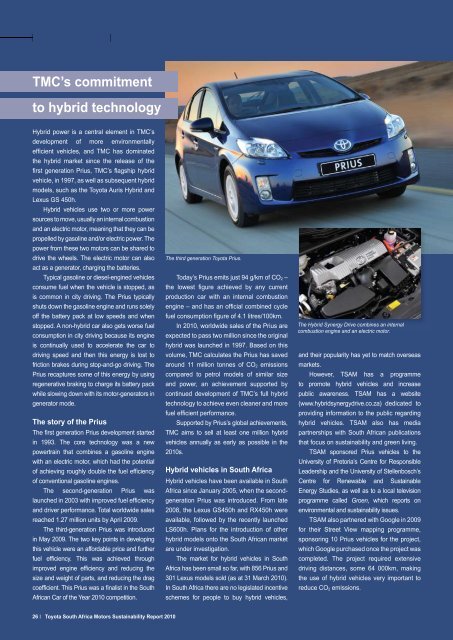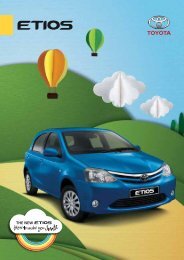to download PDF version - Toyota
to download PDF version - Toyota
to download PDF version - Toyota
Create successful ePaper yourself
Turn your PDF publications into a flip-book with our unique Google optimized e-Paper software.
TMC’s commitment<br />
<strong>to</strong> hybrid technology<br />
Hybrid power is a central element in TMC’s<br />
development of more environmentally<br />
efficient vehicles, and TMC has dominated<br />
the hybrid market since the release of the<br />
first generation Prius, TMC’s flagship hybrid<br />
vehicle, in 1997, as well as subsequent hybrid<br />
models, such as the <strong>Toyota</strong> Auris Hybrid and<br />
Lexus GS 450h.<br />
Hybrid vehicles use two or more power<br />
sources <strong>to</strong> move, usually an internal combustion<br />
and an electric mo<strong>to</strong>r, meaning that they can be<br />
propelled by gasoline and/or electric power. The<br />
power from these two mo<strong>to</strong>rs can be shared <strong>to</strong><br />
drive the wheels. The electric mo<strong>to</strong>r can also<br />
act as a genera<strong>to</strong>r, charging the batteries.<br />
Typical gasoline or diesel-engined vehicles<br />
consume fuel when the vehicle is s<strong>to</strong>pped, as<br />
is common in city driving. The Prius typically<br />
shuts down the gasoline engine and runs solely<br />
off the battery pack at low speeds and when<br />
s<strong>to</strong>pped. A non-hybrid car also gets worse fuel<br />
consumption in city driving because its engine<br />
is continually used <strong>to</strong> accelerate the car <strong>to</strong><br />
driving speed and then this energy is lost <strong>to</strong><br />
friction brakes during s<strong>to</strong>p-and-go driving. The<br />
Prius recaptures some of this energy by using<br />
regenerative braking <strong>to</strong> charge its battery pack<br />
while slowing down with its mo<strong>to</strong>r-genera<strong>to</strong>rs in<br />
genera<strong>to</strong>r mode.<br />
The s<strong>to</strong>ry of the Prius<br />
The first generation Prius development started<br />
in 1993. The core technology was a new<br />
powertrain that combines a gasoline engine<br />
with an electric mo<strong>to</strong>r, which had the potential<br />
of achieving roughly double the fuel efficiency<br />
of conventional gasoline engines.<br />
The second-generation Prius was<br />
launched in 2003 with improved fuel efficiency<br />
and driver performance. Total worldwide sales<br />
reached 1.27 million units by April 2009.<br />
The third-generation Prius was introduced<br />
in May 2009. The two key points in developing<br />
this vehicle were an affordable price and further<br />
fuel efficiency. This was achieved through<br />
improved engine efficiency and reducing the<br />
size and weight of parts, and reducing the drag<br />
coefficient. This Prius was a finalist in the South<br />
African Car of the Year 2010 competition.<br />
26 <strong>Toyota</strong> South Africa Mo<strong>to</strong>rs Sustainability Report 2010<br />
The third generation <strong>Toyota</strong> Prius.<br />
Today’s Prius emits just 94 g/km of CO2 –<br />
the lowest figure achieved by any current<br />
production car with an internal combustion<br />
engine – and has an official combined cycle<br />
fuel consumption figure of 4.1 litres/100km.<br />
In 2010, worldwide sales of the Prius are<br />
expected <strong>to</strong> pass two million since the original<br />
hybrid was launched in 1997. Based on this<br />
volume, TMC calculates the Prius has saved<br />
around 11 million <strong>to</strong>nnes of CO2 emissions<br />
compared <strong>to</strong> petrol models of similar size<br />
and power, an achievement supported by<br />
continued development of TMC’s full hybrid<br />
technology <strong>to</strong> achieve even cleaner and more<br />
fuel efficient performance.<br />
Supported by Prius’s global achievements,<br />
TMC aims <strong>to</strong> sell at least one million hybrid<br />
vehicles annually as early as possible in the<br />
2010s.<br />
Hybrid vehicles in South Africa<br />
Hybrid vehicles have been available in South<br />
Africa since January 2005, when the secondgeneration<br />
Prius was introduced. From late<br />
2008, the Lexus GS450h and RX450h were<br />
available, followed by the recently launched<br />
LS600h. Plans for the introduction of other<br />
hybrid models on<strong>to</strong> the South African market<br />
are under investigation.<br />
The market for hybrid vehicles in South<br />
Africa has been small so far, with 856 Prius and<br />
301 Lexus models sold (as at 31 March 2010).<br />
In South Africa there are no legislated incentive<br />
schemes for people <strong>to</strong> buy hybrid vehicles,<br />
The Hybrid Synergy Drive combines an internal<br />
combustion engine and an electric mo<strong>to</strong>r.<br />
and their popularity has yet <strong>to</strong> match overseas<br />
markets.<br />
However, TSAM has a programme<br />
<strong>to</strong> promote hybrid vehicles and increase<br />
public awareness. TSAM has a website<br />
(www.hybridsynergydrive.co.za) dedicated <strong>to</strong><br />
providing information <strong>to</strong> the public regarding<br />
hybrid vehicles. TSAM also has media<br />
partnerships with South African publications<br />
that focus on sustainability and green living.<br />
TSAM sponsored Prius vehicles <strong>to</strong> the<br />
University of Pre<strong>to</strong>ria’s Centre for Responsible<br />
Leadership and the University of Stellenbosch’s<br />
Centre for Renewable and Sustainable<br />
Energy Studies, as well as <strong>to</strong> a local television<br />
programme called Groen, which reports on<br />
environmental and sustainability issues.<br />
TSAM also partnered with Google in 2009<br />
for their Street View mapping programme,<br />
sponsoring 10 Prius vehicles for the project,<br />
which Google purchased once the project was<br />
completed. The project required extensive<br />
driving distances, some 64 000km, making<br />
the use of hybrid vehicles very important <strong>to</strong><br />
reduce CO2 emissions.





